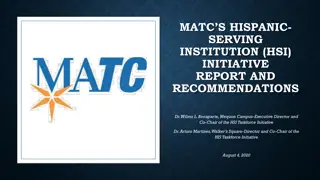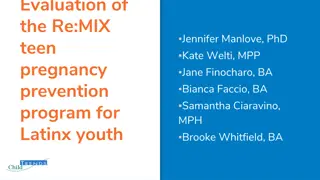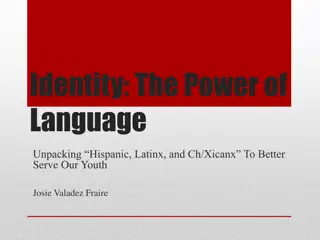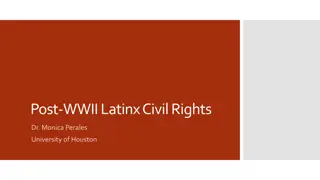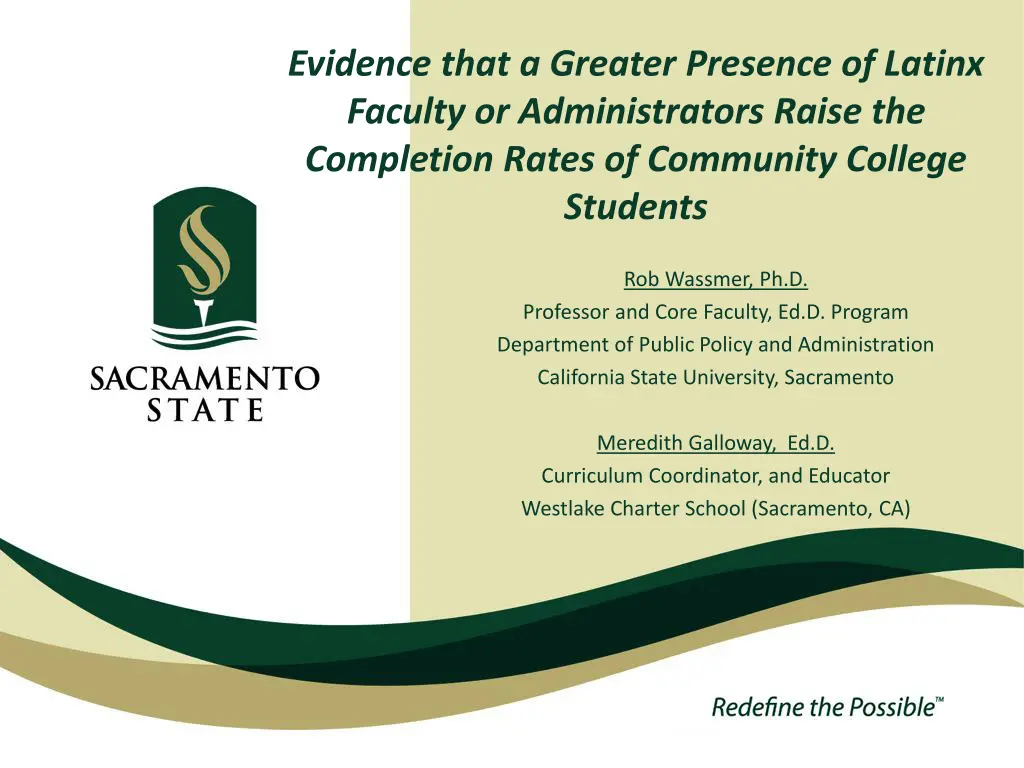
Latinx Faculty Impact on Community College Student Completion Rates
Explore the evidence presented by Rob Wassmer, Ph.D., and Meredith Galloway, Ed.D., on how a greater presence of Latinx faculty or administrators can positively influence the completion rates of community college students. Previous research highlights the importance of faculty diversity for Black and Latinx students, emphasizing the role of diverse faculty in student success and engagement.
Download Presentation

Please find below an Image/Link to download the presentation.
The content on the website is provided AS IS for your information and personal use only. It may not be sold, licensed, or shared on other websites without obtaining consent from the author. If you encounter any issues during the download, it is possible that the publisher has removed the file from their server.
You are allowed to download the files provided on this website for personal or commercial use, subject to the condition that they are used lawfully. All files are the property of their respective owners.
The content on the website is provided AS IS for your information and personal use only. It may not be sold, licensed, or shared on other websites without obtaining consent from the author.
E N D
Presentation Transcript
Evidence that a Greater Presence of Latinx Faculty or Administrators Raise the Completion Rates of Community College Students Rob Wassmer, Ph.D. Professor and Core Faculty, Ed.D. Program Department of Public Policy and Administration California State University, Sacramento Meredith Galloway, Ed.D. Curriculum Coordinator, and Educator Westlake Charter School (Sacramento, CA)
Presentation (30 minutes) Background Previous Research Theoretical Framework Regression Model Data Regression Results Policy Implications Questions?/Discussion (Remainder)
Background Source: National Center for Education Statistics (2019b) Figure 1: Percentages by Race/Ethnicity in the United States Young Adult Population and Bachelor s Degree Holder for 1980 and 2017
Source: California Community College Datamart ( https://datamart.cccco.edu ) Figure 3: Average Percentages in Cohort Achieving Goal of Certificate, Associate Degree, or University Transfer (Ready) in Six-Years at CA Community College by Preparation and Economic Advantage for All and Latinx (Fall 2007 through 2011 Starts with Six Years to Complete)
Sources: CA: California Community College Datamart ( https://datamart.cccco.edu ). US: Digest of Educational Statistics, (2018), Faculty in degree-granting postsecondary institutions, by race/ethnicity, sex, and academic rank: Table 315.2018 ; National Center for Educational Statistics, (2020) Characteristics of Postsecondary Students. Figure 2: Representation of Latinx Students, Administrators, Full-Time, and Part-Time Faculty in CA (top) and US (bottom) Community Colleges, 2015 2017
Previous Research Qualitative (sample) Interviews establish Black and Latinx community college students value faculty diversity (Jordan 2008; Lucero et al. 2017) Black male community college students desire greater faculty diversity, if faculty-student relationship-building is the goal (Pickett et al. 2017) Social capital better generated for all if diverse college students matched with an equally diverse set of administrators and faculty (Turner 2013, Johnson 2010, and Vasquez-Heilig et al., 2019) Role of faculty as validating agents for academic self-concept at a Hispanic Serving Institutions (Alcantar & Hernandez, 2018) Knowledge, appreciation, and sensitivity to Latinx cultures and an understanding of the preferred learning styles of such students create classroom environments that engage them (Cejda & Hoover, 2010) Irony of an under representation of Latinx faculty and administrators at Hispanic Serving Institutions (Contreras, 2017) What happens if raise this representation?
Quantitative (sample) Latinx students attending an institution at which 25 percent or more of their peers also identified as the same, raise odds of third-year persistence by 150 percent (Crisp and Nora, 2010) TN Star Experiment data, own-race K-3 teacher (here, either Black or white) exerts a return of four to five percentile points for math and two to three percentile points in reading when compared to other- race matched students (Dee, 2004) K-12 Black teachers (relative to white) are more effective at raising test scores of Black students with 0.10 increase SD of std test scores. Latinx teachers with Latinx students, the size of the detected effect was 0.02 increase SD (Hanushek et al., 2005) De Anza Community College in Bay Area, raising share of Black instructors by one standard deviation would increase the retention rate by 2.5 percentage points (from a base of 62 percent) closing about a third of the white to Black retention gap but some evidence of white students worse academic performance with Black instructor (Fairlie, Hoffman, and Oreopoulos, 2014)
Theoretical Framework Institutional Departure Model (Tinto, 1975 & 1993) Higher education exit due to a lack of integration into social & academic institutional environments from HS to four-year residential college Important that integration occurs in first year 13 testable propositions mainly not confirmed using CC student data College experience of commuter students that are more likely to live with family Tinto Rethought for CC (Braxton et al., 2004) Causal factors degerming student departure in commuter colleges Student Entry Characteristics, Internal Campus Environment, and the External Environment Acting upon Institutional Commitment to determine the degree of persistence and ultimate completion Social-Academic Integration Model (Deil-Amen, 2011) Institutional agents (faculty and administrators) offer needed validation of students of color at two-year places of higher education, and hence a factor of importance to their persistence and eventual academic success
Regression Model Dependent Variable Six-year cohort completion rate of first-year, first-time students declaring goals of Certificate, associate s degree, university transfer or transfer ready (1) Cohort Completion Rate = f (Student Cohort Characteristics, Institutional Characteristics, External Characteristics). (2) Student Cohort Characteristics = f (Female_Percentage, [Age18to21_Percentage excluded], Age21to24_Percentage, Age25to39_Percentage, Age40Plus_Percentage, [African_ American_Percentage excluded], Asian_Percentage, Filipino_Percentage, Latinx_ Percentage, Native_American_Percentage, Pacific_Islander_Percentage, White_Percentage, Pell_Grant_Recipient_Percentage, Full_Time_Student_Percentage), (3) Institutional Characteristics = f (Number_Credit_Sections, Avg_Enrollment_Per_Credit Section, [Evening_Credit_Section_Percentage excluded], Hybrid_Credit_Section_ Percentage, Educ_Opp_Prog_Enroll_Percentage, Faculty_Full_Time_Percentage, Latinx_Faculty_Full_Time_Percentage, Latinx_Faculty_Part_Time_Percentage, Latinx_Admin_Percentage), (4) External Characteristics = f ([2008_Cohort_Start excluded], 2009_Cohort_Start, 2010_Cohort_Start, 2011_Cohort_Start). And College-Specific Fixed Effects
Data Table 1: Descriptive Statistics. (528 Observations drawn from 108 CA Community Colleges and Five Cohorts starting in the fall of 2007, 2008, 2009, 2010, and 2011) Standard Deviation Variable Name Mean Minimum Maximum Dependent All_Overall_Comp_Rate 46.54 7.93 23.26 67.10 Latinx_ Overall_Comp_Rate 40.25 6.14 18.0 57.90 All_Acad_Prepared_Comp_Rate 68.13 7.05 36.70 83.80 Latinx_Acad_Prepared_Comp_Rate 63.50 9.75 20.00 100.00 All_Acad_UnPrepared_Comp_Rate 39.65 6.50 20.45 60.30 Latinx_Acad_UnPrepared_Comp_Rate 35.38 5.66 16.30 52.70 All_Econ_Advantage_Comp_Rate 52.47 9.45 25.64 80.90 Latinx_Econ_Advantage_Comp_Rate 42.94 12.07 7.10 100.00 All_Econ_DisAdvantage_Comp_Rate 44.29 7.27 22.48 62.74 Latinx_Econ_DisAdvantage_Comp_Rate 39.68 6.09 18.40 59.30 According to this CCC Chancellor Office distinction, an economically disadvantaged student: (1) received a Board of Governor's Waiver or PELL grant, or (2) is a CalWorks or Workforce Investment Act participant, or (3) is a Department of Social Services TANF client. For the cohort data used here, prepared for college was determined by level of English and math courses completed in high school. Using this deficit framework, which since has been increasingly questioned, an unprepared student was required to take either a high-school level math or English course based on placement testing. Signed into law in 2017, Assembly Bill (AB) 705 alters this institutional norm of sorting students into remedial high-school-level coursework based on English language and mathematics placement testing outcomes. Using more of an asset framework, this bill dictates the placement of first-year California college students into classes that optimize their opportunity to complete transfer-level math and language arts courses within one year of enrollment in its initial implementation phase. Furthermore, the statute limits placement into remedial courses to students who are "highly unlikely to succeed without them" (California Community College Chancellor s Office, 2017, p. 1). It prohibits such placement based upon standardized placement tests alone.
Regression Results Table 2: Regression Results Using Completion Rate of Various Latinx Student Cohorts as the Dependent Variable^ Also tried interactions terms with Latinx_Percentage students and data set All Student Cohorts. Dependent Variable Overall_ Comp_Rate Acad_Prep_ Comp_Rate Acad_UnPrep _Comp_Rate Econ_Adv_ Comp_Rate Econ_DisAdv _Comp_Rate Explanatory Variable 0.050** (0.19) 0.065 (0.053) 0.080*** (0.020) 0.219*** (0.050) 0.036* (0.020) Faculty_Full_Time_Percentage 0.211** (0.088) 0.565*** (0.115) 0.113 (0.085) 0.399*** (0.133) 0.240*** (0.088) Latinx_Faculty_Full_Time_Percentage 0.043 (0.047) -0.560*** (0.049) 0.086** (0.041) -0.140 (0.128) -0.003 (0.048) Latinx_Faculty_Part_Time_Percentage 0.035*** (0.013) 0.121*** (0.018) 0.020** (0.009) 0.128** (0.062) 0.031*** (0.007) Latinx_Admin_Percentage ^ Using STATA xtscc command with lag (4) and college-specific fixed effects. Statistical Significance in Two-Tailed Test: ***99% +, **95 to 98.9%, and *90 to 94.9%. We use a two-tailed test for which a p=0.10 is the same as p=0.05 in a one-tailed test, or 95% confident that a regression coefficient is different from zero. If the reader prefers 95% confidence in even a two-tailed test, they can only count results with two or three asterisks.
Summary of Fixed-Effects, Panel-Data Regression Results Latinx Cohorts Academically Prepared Academically Unprepared Economically Advantaged Economically Disadvantaged Explanatory Variable Overall positive Latinx Full-Time Faculty % (negative beyond 56% Latinx students) positive positive none positive negative (positive beyond 53% Latinx students) Latinx Part-Time Faculty % none negative positive none negative (positive beyond 31% Latinx students) Latinx Administrator % positive positive positive positive All Race/Ethnicity Cohorts Academically Prepared Academically Unprepared Economically Advantaged Economically Disadvantaged Explanatory Variable Overall negative (positive beyond 45% Latinx students) negative (positive beyond 41% Latinx students) Latinx Full-Time Faculty % negative negative none negative (positive beyond 49% Latinx students) negative (positive beyond 48% Latinx students) Latinx Part-Time Faculty % positive positive positive positive Latinx Administrator % positive positive positive positive
Policy Implications A higher percentage of Latinx administrators, at the margin, increases the community college completion rates of both Latinx student cohorts and all race/ethnicity cohorts. If the percentage of full-time professors that are Latinx increases at a community college, at the margin, the result is likely to be an improvement in nearly all Latinx cohort completion rates. Expect this action to do the same for the overall and academically prepared completion rates of all race/ethnicity cohorts if Latinx students at the college are in the majority. Increase the percentage of part-time instructors that are Latinx and expect, at the margin, a positive influence on the completion rates of the academically unprepared Latinx cohort and the economically advantaged Latinx cohort if greater than half of the students at college Latinx. This same expansion of Latinx part-time faculty representation likely raises the whole race/ethnicity cohort completion rates for the overall group, academically unprepared, and economically disadvantaged. For the academically prepared and economically disadvantaged, the expectation is that hiring more Latinx part-time instructors increases these cohort completion rates if again, Latinxs are the student majority at the college.
Questions?/Discussion Paper s current status is revise and resubmit at Educational Policy Send me an email if want a copy of presentation or working paper Any questions? Your reactions to the results?







